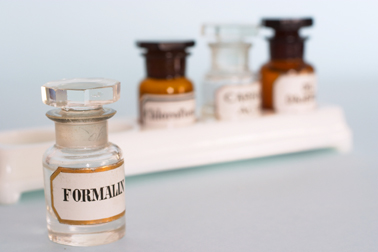
By TreeLiving
If you haven’t heard of formaldehyde you’ve certainly come across it in daily living. We’ve all seen images of creatures and organs embalmed in laboratory jars. The powerful chemical preservative used is formalin, a solution of formaldehyde diluted with water. Formaldehyde is a toxic, colorless substance made up of carbon and hydrogen atoms that is widely used in a whole host of industrial processes and is found in numerous consumer goods, from building materials to household products – bad news for anyone trying to live a green lifestyle.If you haven’t heard of formaldehyde you’ve certainly come across it in daily living. We’ve all seen images of creatures and organs embalmed in laboratory jars. The powerful chemical preservative used is formalin, a solution of formaldehyde diluted with water. Formaldehyde is a toxic, colorless substance made up of carbon and hydrogen atoms that is widely used in a whole host of industrial processes and is found in numerous consumer goods, from building materials to household products – bad news for anyone trying to live a green lifestyle.
Formaldehyde occurs in tiny quantities as a by-product of the metabolism of living things and at these low concentrations is a normally occurring environmental substance. At higher levels it is highly toxic to all animals, no matter what form it is in and no matter how it is encountered. At room temperature pure formaldehyde is a gas. What this also means is that it is a volatile chemical. Goods containing formaldehyde may give off invisible fumes that may not even be possible to detect by smell. In liquid form it is also easily absorbed through the skin.
Notable sources of formaldehyde in the environment include glues, home insulation materials, pressed woods and paper products. It is a by-product of burning, and a well known hazard associated with inadequately vented stoves and kerosene heaters, as well as vehicle tailpipe emissions and cigarette smoke. But the big question is: what does exposure in sub-lethal doses mean?
According to the National Cancer Institute, short term exposure to environmental formaldehyde in its gaseous form can cause watery eyes, and ear, nose, throat and skin irritation. It can also cause respiratory problems like coughing and wheezing, as well as nausea. Formaldehyde sensitivity varies from person to person.
Less is known about longer term exposure but formaldehyde has been regarded as a possible (and probable) cause of cancer in humans for twenty-five years. It is known to cause cancer in rats. Studies have suggested that people working with this chemical seem to be more susceptible to brain cancer and myeloid leukaemia, though other studies have shown no obvious linkage.
In spite of the fact that the evidence isn’t black and white, there can be no doubt that susceptible individuals may be running a risk by exposing themselves to the chemical and avoiding unnecessary exposure is recommended. In particular, environmental health bodies recommend caution regarding pressed wood products, including plywood and fibreboard, inside the home. Exterior grade pressed wood uses different resins that are likely to be safer. Formaldehyde in cosmetic products like nail polish and hair straightening compounds has come under the spotlight but no studies have been conducted to firmly establish a link with disease.
It is likely that a century from now people will look back in horror at the environmental substances we are exposed to, just as we today see exposure to lead, mercury, asbestos and other toxic substances. A sound policy is to be aware of the building materials already in your home, and any that you plan to bring in, in the interests of preventive health care and green living.

